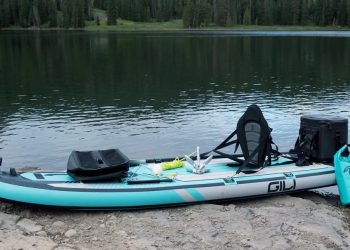The winter season changes the landscape of the UK, stirring the woodlands and shores with winds and rainfall all as the temperatures drop. For some, this period is a time of hibernation. For others, their outdoor activities change or adapt to bring about new possibilities.
It is, for example, no longer uncommon to see groups and individuals swimming in wild waters on a winter’s day. In fact, cold water swimming has become immensely popular across the world. Similarly, stand-up paddleboarding, also known as SUP, has its own bustling community that takes to enjoying waterscapes specifically during the winter months.
Some paddleboarders are motivated by the respite. Many stunning locations not only become much quieter during the winter, being free from summer traffic, but also more serene and tranquil in their nature. For others, it is the excitement of a more extreme landscape, one that has different challenges to those experienced during the summer. Regardless of your motivation to paddleboard during the winter, it is important that safety considerations are made, especially for those relatively new to SUP.
Communication & Company
Having the seafront and lake to yourself is an immense pleasure, allowing for the peaceful exploration of beautiful waters. However, the very nature of locations being less occupied by tourists also means there is less danger of your paddleboarding being monitored. As such, individuals should both relay their intended adventure with others or, preferably, enjoy the experience with friends.
By ensuring that others are aware of your location or bringing along friends to join your adventure, you are guaranteeing that, should anything go wrong, you have others who are there to help.
Adding Layers
Staying warm is a fundamental aspect of being outdoors that most are aware of. However, when it comes to paddleboarding, there is a lot more to think about. Alongside temperatures often being colder on the water, especially in areas with little cover, there is also the exertion associated with the watersport to consider.
All physical activities will encourage you to sweat and if this moisture is drawn from the body as you paddleboard, you will start to feel colder more quickly. As such, it is important to add layers and ensure that base layers are keeping you warm by drawing sweat away from your body.
Choose Your Hours
Winter brings a more limited period of visibility for the UK and paddleboarders should change their routine accordingly. Venturing out onto the water during low light can be risky, making it more difficult to navigate safely and foresee potential risks.
Be sure to plan your time on the water thoroughly, with a clear aim as to when you want to be back on land. Low light not only makes it more difficult to return safely but brings about significantly colder temperatures too.
Equip Yourself
It can be easy to find yourself suddenly caught in the rain, especially during winter. However, only those who are unprepared will find this change in climate causes issues. Waterproof bags and changing robes are brilliantly useful, helping to protect paddleboarders if the weather should suddenly turn.















